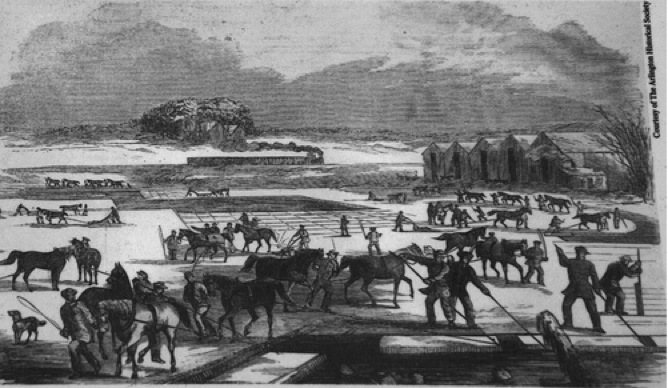For most of Winter in the Northeast, skating is possible only during the somewhat rare times when the ice is thick and not covered with snow or other unwelcome surface conditions. And bad skating has been the story, typically, for most of this Winter around Boston. After an earlier snow, there were some ad hoc skating rinks cleared by shoveling, but those were ruined by rains, more snow, more rains, and intermittent freezes that made a hash of the surface. But recent rains and hard freezes have formed wide paths between remaining islands of ruined snow. On most ponds there aren’t enough open spaces for real hockey games, but there’s plenty enough for skating, and for hockey practice, anyway. (A note to newbies and outsiders: nearly all lakes here are called ponds. Dunno why yet. Maybe one of ya’ll can tell me. Still a bit of a noob myself.)
Hockey practice is what I saw when I paused to take a sunset shot with my phone at Spy Pond, which I passed it late this afternoon on a long walk along the Minuteman Bikeway, which is one of my favorite walking paths (and thoroughfares — at least when it’s warm and clear enough to bike on). As it happens, Spy Pond ice has some history. There was a period, in the mid- to late-1800s, after railroads got big, but before refrigeration came along, when New England was a source for much of the world’s shipped ice. And Spy Pond itself was one of the most productive sources. This picture here…
… shows ice being harvested for storage in ice houses beside the railroad which is now the Bikeway. I stood near the left edge of this scene when I took the picture at the top, and the boy and his dad playing hockey were about where at the center left, where a horse is shown pulling what looks like a man with a plow. (That last shot is from this historical display alongside the bikeway.)
The brainfather of Boston’s ice industry was Frederic Tudor, about whom I have learned a great deal from The Ice King: Frederic Tudor and His Circle. Highly recommended, if you’re into half-forgotten New England history. The book came as a bonus with membership in Mystic Seaport, a terrific maritime museum down the road on the Connecticut coast.
[Later…] The industry you see depicted above can also serve as a metaphor. For that a hat tip goes to Robin Lubbock (@RLma), New Media Director of WBUR, who pointed me to this piece by Michael Rosenblum. Nails it. (I also love Rosenblum’s Maybe monetizing is not the answer and Edward III, Crecy and Local TV Newsrooms, also via Robin.)


Leave a Reply